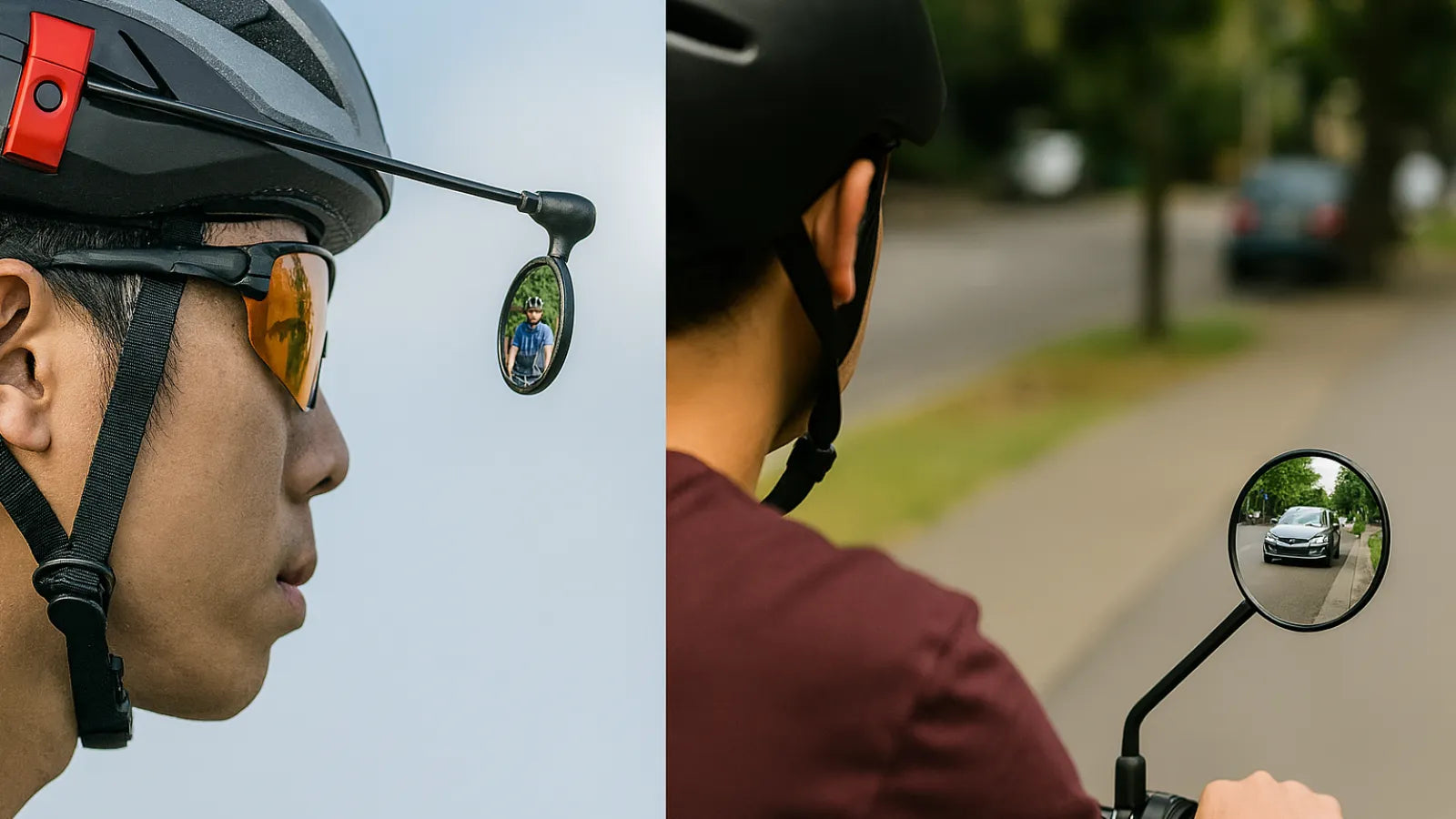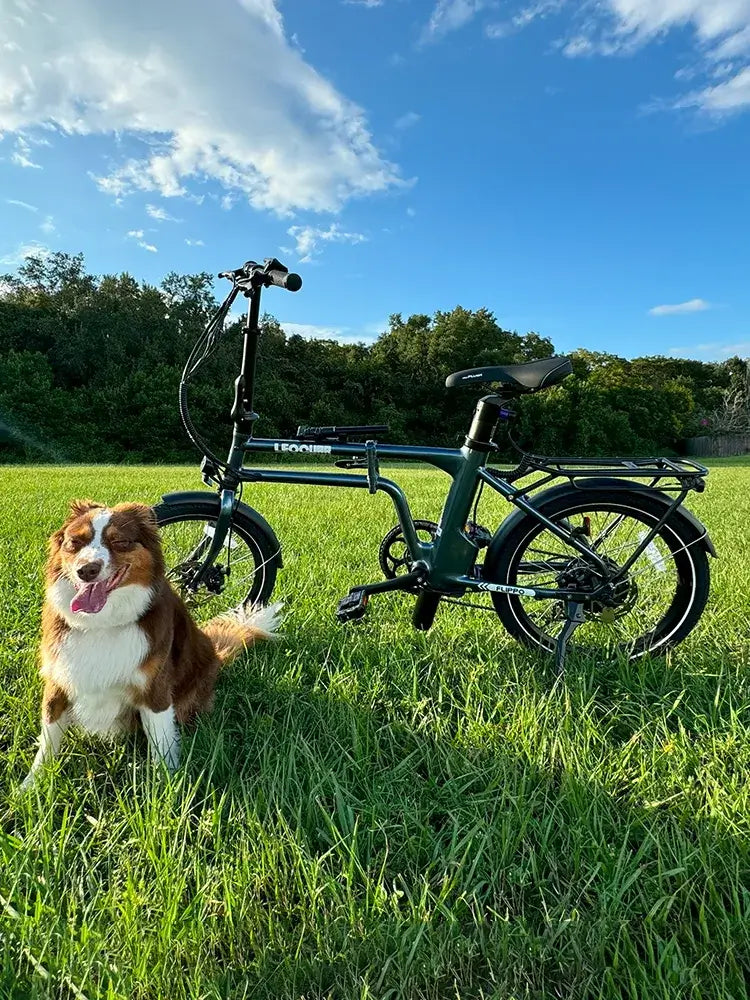
Bike Helmet Mirror vs Handlebar Mirror: Which One’s Better for You?
Why a Bike Mirror Matters for Rear Visibility
When you ride through a busy city or down a winding country road, you focus on what's ahead. But what about what's behind you? Electric cars approach silently, cyclists speed up from behind, and vehicles get ready to pass you. For cyclists, knowing what's around you isn't just nice to have—it's essential for staying safe. This is where cycling mirrors help, giving you a view behind without turning your whole head around.
The two main options are the bike helmet mirror and the handlebar mirror. So which one is right for you? There's no single best answer for everyone. Your choice depends on how you ride, what feels comfortable, and what kind of bike you have. This guide will help you understand the differences and choose with confidence.
Bike Helmet Mirror vs Handlebar Mirror: Quick Comparison
Here's a fast look at how bike helmet mirrors and handlebar mirrors compare. The main difference is simple: helmet mirrors move with your head, while handlebar mirrors stay fixed to your bike.
| Feature | Bike Helmet Mirror | Handlebar Mirror |
|---|---|---|
| Field of View | Wide and dynamic; follows your head movement. | Fixed and narrower; can have blind spots from your arm/body. |
| Stability | Generally stable; your body absorbs most road vibrations. | Prone to vibration on rough surfaces, potentially blurring the image. |
| Learning Curve | Steeper; requires practice to use effectively with quick glances. | Minimal; intuitive for anyone who has driven a car. |
| Installation | Attaches to the helmet via adhesive, clips, or straps. | Mounts into the bar-end or clamps onto the handlebar. |
| Best For... | Urban commuters, touring cyclists needing a wide view. | Road cyclists, casual riders, those who prefer a fixed view. |
| Potential Downsides | Can be knocked out of alignment, requires focusing practice. | Vulnerable to damage in a fall, adds width to handlebars. |
Pros and Cons of Using a Bike Helmet Mirror
A bike helmet mirror is a small, light mirror on an arm that attaches to your helmet. You can attach it with sticky pads, clips that grab the helmet's edge, or straps that wrap around the helmet. The mirror sits in the corner of your vision where you can see it.
Pros:
- Clear, Wide View: The mirror moves with your head, so a small turn lets you see the whole road behind you. You can look into corners or check other lanes before you even start to turn your handlebars. This gets rid of blind spots that other mirrors might have.
- Always With You: Since the mirror attaches to your helmet, it goes everywhere you go. This helps a lot if you ride different electric bikes, because you don't need a separate mirror for each one.
- Less Shaky: Your neck and body absorb vibrations naturally. Even on rough roads or light gravel, the helmet mirror view stays much clearer than a handlebar mirror that shakes.
Cons:
- Takes Practice: Getting used to a bike helmet mirror needs patience. At first, you might look at the mirror too much instead of watching the road ahead. The trick is to practice quick looks, like using a car's rearview mirror, instead of staring at it. It feels weird at first, but after a few rides, it becomes natural.
- Helmet Issues: Not all helmets work well with mirrors. Helmets with lots of vents, sharp edges, or no flat spot on the front-left area can make mounting hard.
- Gets Knocked Around: The mirror needs to be in the perfect spot to work well. Bumping your helmet, taking it on and off, or storing it can move the mirror out of place, so you need to adjust it often.
Is a Handlebar Mirror the Better Option?
Handlebar mirrors attach directly to your bike. They come in two main types: bar-end mirrors that fit into the open end of your handlebars, and clamp-on mirrors that use a bracket to mount anywhere on the handlebar.
Pros:
- Steady View: The mirror's view always stays the same compared to the bike. You always know exactly where to look to see behind you, which feels more predictable and less tiring for some riders.
- Easy to Use: There's almost no learning needed. It works like a car's side mirror, so it feels familiar right away and fits into your checking habits easily.
- Less Distracting: For cyclists who find a mirror in their side vision bothersome, a handlebar mirror keeps the view completely separate from where they're looking ahead.
Cons:
- Vibration Problems: This is the biggest issue. On anything but the smoothest roads, vibrations travel up the frame and through the handlebars, making the mirror shake and the image blurry and hard to use.
- Limited View: The view is fixed and your arm or body can block part of it, especially if you lean forward a lot. You see what's directly behind you, but not what's in the next lane over.
- Breaks Easily: Handlebar mirrors stick out, making them easy to damage. Leaning the bike against a wall, going through tight spaces, or falling can easily break or move the mirror.
- One Bike Only: The mirror stays on one bike. If you regularly switch between different bikes, you'll need a separate mirror for each one.
Helmet or Handlebar Mirror: Which Fits Your Ride Style?
Let's look at which mirror works best for different types of cycling.
For the Urban Commuter-Bike Helmet Mirror
In busy city traffic, a helmet mirror works best. You need to check for cars in multiple lanes, watch for people walking, and clear intersections from all directions. Being able to scan everything behind you with a quick head turn gives you awareness that a fixed handlebar mirror can't match. It lets you look around blind spots, which helps a lot when you want to change lanes or turn left.
For the Long-Distance Road Cyclist-Handlebar Mirror
When you're riding for hours in a forward-leaning position, reducing fatigue matters most. A handlebar mirror gives you a steady, reliable view without making you move your head or neck constantly. On long, open roads, you mainly worry about vehicles coming from directly behind, which is exactly what a handlebar mirror shows best. Well-made handlebar mirrors work great for road cycling where smooth surfaces reduce vibration.
For the Mountain Biker and Trail Rider-Neither, or a very tough Bike Helmet Mirror
This is where mirrors often cause more problems than they solve. Handlebar mirrors are almost useless because of extreme shaking and will probably get broken by trees or crashes. A helmet mirror works better since your body absorbs bumps, but it can also get caught on low branches or knocked around during hard riding. On technical trails, you should focus completely on the path ahead, and using your ears and quick shoulder checks is often safer.
Mirror Setup Tips and Best Riding Practices
Picking a mirror is only half the job. Setting it up right and using it properly turns it from a gadget into a real safety tool.
Setting Up Your Helmet Mirror
- Placement is Key: Put the mirror on the front-left edge of your helmet. You want it just at the edge of your vision when looking forward—not blocking your view, but easy to see. For helmets without visors, some mirrors attach to glasses, which gives another stable option.
- The Distance Trick: With your helmet on and in your normal riding position, adjust the mirror arm. Get the mirror far enough from your eye so you can see the image clearly without having to refocus. You should see the road behind you with just a quick look, not a full head turn.
- Practice Quick Looks: The most important skill is learning the fast, short glance. Don't stare at the mirror. Practice in a safe, empty area. Ride straight, look at the mirror for a split second, notice what's there, and look back at the road ahead.
Installing Your Handlebar Mirror
For bar-end mirrors, make sure they fit firmly inside the handlebar. For clamp-on models, tighten the clamp enough so it doesn't move, but not so much that you damage carbon handlebars. A great tip to reduce vibration is to put a small piece of old inner tube between the clamp and handlebar before tightening. This absorbs some of the shaking.
Beyond the Mirror
Remember, a mirror helps but doesn't replace basic safety skills. It's a tool for getting information, but should never replace looking over your shoulder before making big moves like changing lanes. Always use mirror checks along with basic safe cycling like riding predictably, using clear hand signals, and keeping control of your bike.

Making Your Confident Choice
The choice between a bike helmet mirror and handlebar mirror isn't about which one is always better, but which is better for you. There's no universal winner, only what works best for your needs. By understanding the main trade-offs and matching them with how you mainly cycle, you can choose something that makes you safer and enjoy riding more.
To make your final decision, think about this:
- Choose a bike helmet mirror if: You commute in the city, you ride multiple bikes, you want the widest possible view, and you're willing to spend time learning to use it well.
- Choose a handlebar mirror if: You do road or casual cycling, you mainly ride one bike on smoother roads, you want something simple that works right away, and you prefer a view that's separate from where you look ahead.
Whatever you choose, a mirror is one of the best and cheapest safety upgrades you can make. It changes you from a cyclist who can only guess what's behind into one who knows. Ride on, and ride safe.
FAQ
1. Q: Can I use both a helmet mirror and handlebar mirror at the same time?
A: Yes, some cyclists use both for maximum coverage. However, this can be overwhelming at first and may cause more distraction than benefit. If you try both, start with one and add the second only after you're comfortable with the first.
2. Q: Will a helmet mirror work with my sunglasses?
A: Most helmet mirrors work fine with sunglasses. Some mirrors even attach directly to glasses frames. Just make sure the mirror doesn't interfere with putting on or taking off your sunglasses.
3. Q: How often do I need to adjust my bike helmet mirror?
A: You'll probably need small adjustments every few rides at first. Once you find the perfect position and get used to the mirror, adjustments become less frequent. Taking your helmet on and off carefully helps keep the mirror in place.
4. Q: Do handlebar mirrors work on all types of bikes?
A: Bar-end mirrors only work on bikes with open handlebar ends, like flat bars or some drop bars. Clamp-on mirrors work on most handlebars but may not fit well on very thick or unusually shaped bars. Check compatibility before buying.
5. Q: Are bike mirrors legal everywhere?
A: In most places, bike mirrors are completely legal and encouraged for safety. Some areas even require them for certain types of cycling. Check your local cycling laws, but mirrors are generally seen as a positive safety addition.
















































Leave a comment
Please note, comments must be approved before they are published.
This site is protected by hCaptcha and the hCaptcha Privacy Policy and Terms of Service apply.